Introduction
The purpose of this marketing assignment is to illustrate conceptual framework of steps to assess and penetrate in a new market or a selected country with a particular product. To do so, this study has selected Bangladesh as a new market and affordable low priced cars of RAK (UAE) as new product while final product would be assembled with imported components by using domestic labour forces and locally available resources.
First Screening – Basic Needs
Habib (1) reported that highly populated Bangladesh is one of the biggest importer of Japanese old cars with tremendous market demand, but the government has setup embargo for not to import vehicles less than three years as the county is suffering emissions from old automobiles.
The government also set Euro emission norms along with different measures to reduce emissions from automobiles, but due to high rush of passengers and transport crisis, it is difficult to maintain the standards boldly where one car per one thousand citizens in context of population census of 2003.
The most hazardous scenario of roads and highways of Bangladesh are the rickshaws, a mechanical three-wheeler pulled by human that generates traffic system failure and the policymakers are deeply concerned to keep a stopple for such manual rickshaws by small vehicles.
The market needs of automobiles in Bangladesh is similar to any other developing countries where both the commercial and private use of vehicles play a noteworthy role to facilitate citizens to move any time and to carrying their goods and raw materials anywhere (“Demand for Used Cars Surges” par. 1).
Beside the individualized requirement, the market also huge demand for public service vehicles, export mobility agricultural purposes and so on, while a very fewer comes from local assembling and most of the supplied from used and reconditioned foreign companies both light and heavy motor vehicles.
The automobile sector of Bangladesh is flourishing due to increasing income level, export growth and rinsing balance of trade, development of roads and highways, and availability of financial support from the financial institutions, every public and private bank have “Car Loan Program” with competitive offerings.
At the same time, governmental emphasis on the improvement of transport and communication, effectual transport policy, financing from formal and non-formal such as renal and leasing companies and availability of local natural gas for fueling are the major reasons of increasing demand for affordable motorcars. Thus, the affordable motorcars would be an appropriate solution for private transportation.
Habib (3) pointed out that the Bangladeshi motor vehicles users have to pay 120% load of heavy duty and taxation, which makes the price higher than the price of new cars in the developed countries. Thus, by setting up an assembling plant here by using local labor forces and domestic resources, the proposed car marketer would attain further 80% of cost saving and such costing benefit would generate enhanced scope for the people to obtain a brand new car.
At the same time, involvement of local human resource and talent for assembling and marketing would generate employment opportunities and keeps remarkable contribution to the national GDP growth and this car assembly plant would flourish a new horizon for Bangladesh with enough opportunities to explore it power of innovate.
Second Screening -Financial and Economic Forces
The overall economy of this country has maintained a steady and satisfactory growth though there are many problems to make a good business environment, for instance, unrest political situation, poor, corruption, infrastructural inadequacies impeding FDI growth, and so on; however, the policy makers have tried to change economy within 2021 (Huq 8; and “Country Profile of Bangladesh” par. 1).
At the same time, it is an optimistic factor for the investors that the government of Bangladesh has concentrated on the digitalization and diversification of national economy in order to change economy in true sense; however, 6% real GDP growth trend, and 7.5% CPI inflation rate, and foreign exchange reserves, inflow of remittances, and development of export sectors
GDP Growth
According to the financial report of Bangladesh Bank, industrial and services sectors had experienced remarkable growth 9% and near 6% respectively; however, in the fiscal year 2013, Bangladesh achieved a notable economic growth in spite of political disturbance and the overall real GDP growth was 6% (Huq 40); however, the following figure give more details about real GDP growth rate:
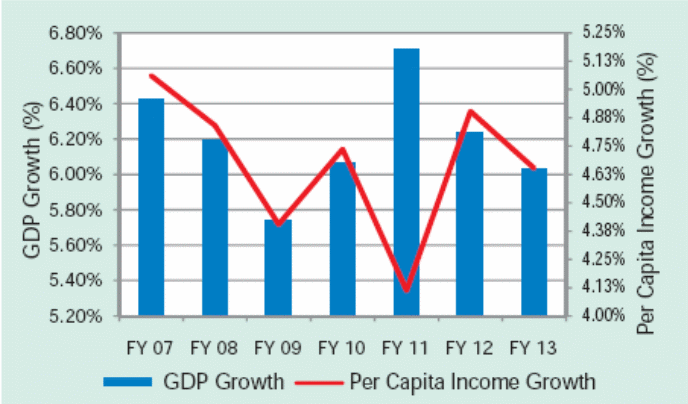
In accordance with the report of Indexmundi, GDP on a purchasing power parity basis divided by population is not too impressive at present; for instance, it was the highest in 2006 (about $2300), but it reduced over time due to many external and internal influences; however, the next figure regarding GDP per capita (PPP) shows this in more detail.
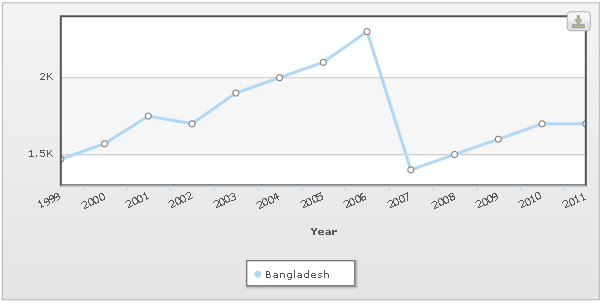
Inflation
Huq (41) reported that the CPI inflation had increased from 2007 though it is under control as the data demonstrated a downward trend in the fiscal year 2013; however, the next figure give more information about CPI Inflation:
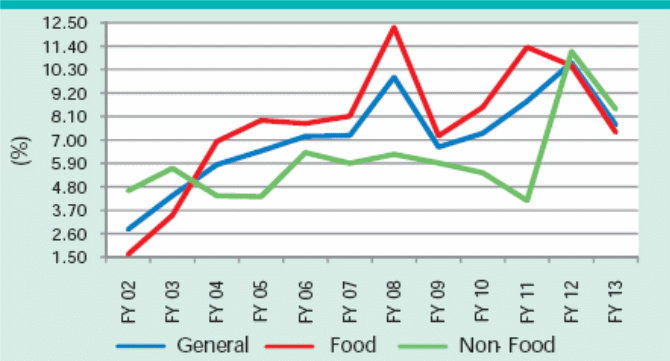
Exports from Bangladesh (2006 to 2013)
Simoes (1) stated that apparels sustained to occupy an overwhelming share of the export market as Garment exports covered 80% of total exports and 18% of national GDP; furthermore, exports partners are the United States, Germany, the UK, France, Spain, Italy, Canada. However, the following table give more information:
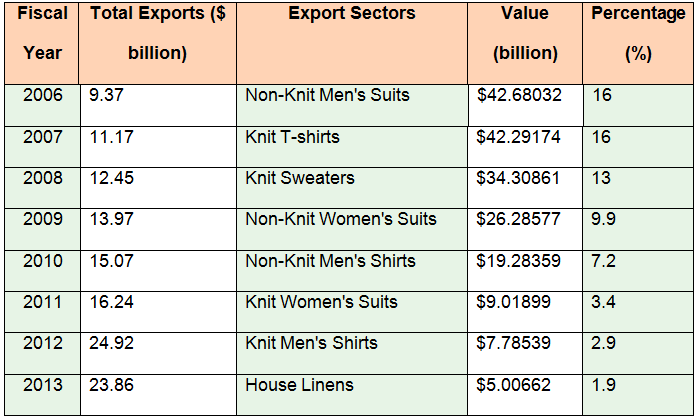
Imports (2006 to 2013)
The report of Indexmundi (1) demonstrated that machinery and equipment, chemicals, iron and steel, apparel, foods, fuel, and cement electronics are the main import items; however, next table gives more information about imports:
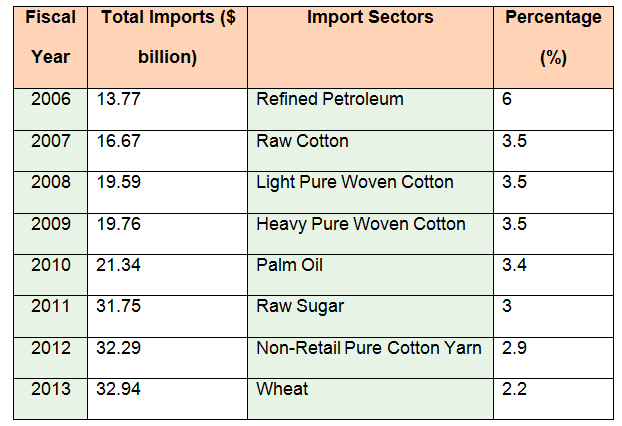
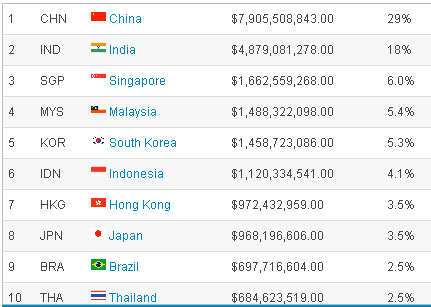
On the other hand, Huq (41) reported that in 2013, import costs had decreased for rice, sugar, edible oil, spices, and milk; in addition, earning from exports increased from footwear, leather and leather products; however, next figure shows import and export growth rate:
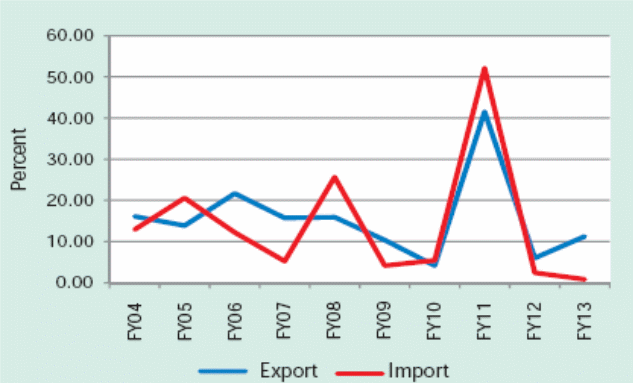
Foreign Direct Investment

Third Screening – Political and Legal Forces
After two hundred years of British colonial regime collapsed in India in 1947, India was divided into two parts India and Pakistan, and Bangladesh became independent from the economic and political suppression of Pakistan in the name of religion in 1971 as a multi-party parliamentary democratic county with the core essence of secularism.
The people of Bangladesh are moderate Muslim, but not radicalism like Pakistan. In Bangladesh, the parliamentary election held in every five years, the president as the head of state elected by the parliamentarians while prime minister is the leader of the parliament and exercises executive power like other parliamentary democratic countries.
There are a number of political parties, but most of them are in alliance under two major parties one is from the liberation forces that lead the county to the independence and the other is anti-liberation force who aligned to keep the country under the control of Pakistan.
There were some political unrest in last year to protect the trail of war criminals, but now the political situation is quite stable.The Judeciary of Bangladesh is theoretically independent and they are continuing to put into practice of working without any interference of government or any political influence.
The business law of Bangladesh has amended to facilitate the foreign investment, at the same time government has designed many packages for overseas business community including immigration law, and export-processing zone, while the country is a member country of the World Bank and signed WTO, it demonstrates enough liberalization to attract foreign business community.
As a market, Bangladesh is exploring itself as the next rising star among the South Asian counties by attracting its foreign investment, policy reformation, emphasizing on open market economy, strengthening private sector, and appropriate addressing to the climate change, labor relationship with management aimed to experience sustained development.
With an area of about 147,570 KM2 Bangladesh has a population of 162.22 million and it is the top seventh population density in the world, such a large population in the small area, the multinationals considers it as one of the potential market (Indexmundi, 1).
Forth Screening – Socio-Cultural
Bangladesh has people from different cultural and religious backgrounds, but most of them are Muslim; citizens of this country are well-mannered, hardworking, and motivated; therefore, multinational auto manufacturers have opportunity to develop a friendly working environment and a casual corporate culture to sustain in the market with large market share.
However, the demand of low priced cars has increased to the middle-class people for different social-cultural reasons, for instance, priority on transport and communication development, government strategy to withdraw Baby taxis from Dhaka, traffic congestion problem, unavailability of transport in the road, anti-social activities in the public transport and so on.
Fifth Screening – Competitive Forces
It is important to note that Bangladesh is one of the main prospective markets for the car manufactures, but there is no renowned local and international Auto manufacturing company though the demand for automotive has increased significantly over time; recently, Walton HIL is going to manufacture cars by taking technological support from Japan. Habib (1) argued that middle-class people of this country would like to purchase cars at affordable price, but they do not get low priced cars because it has to import vehicle from abroad by spending high taxes.
However, Habib (1) said that Japanese auto-manufacturers particularly Toyota have captured over 80% of the total market share of car industry in Bangladesh; on the other hand, Chinese, Korean, Indian, and auto-manufacturers of other countries have tried to build strong brand image to become large payer in this market and some companies tried to penetrate market with lucrative product line.
As a result, local manufacturers, such as, Pragoti, Bangladesh Machine Tools Factory, Aftab Automobile and other companies captured very small parts of the market share; however, the following table gives more information in this regard:
Table 4: Transport market description. Source: Self generated.
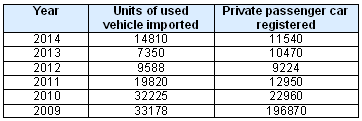
At present, multinational auto-manufacturing companies are realizing the market demand of cars at reasonable price, for example, TATA entered in this market by targeting middle-class society and it uses different promotional tools to attract customers.
Sixth Screening – Final Selection
RAK of (UAE) has imported substitutions automobile assembly and manufacturing plant in Ras Al-Khaimah free trade zone that enjoys competitive landscape of 100% tax exemptions and offers low cost light vehicles that would fit the market demand of affordable cars in the Bangladeshi market.
RAKIA (3) pointed out that the changing dynamics of global automobile market illustrated that the demand for passenger motor vehicles in the developing countries have raised at 11% while the production has increased only 4% to 5% and to address this gap, RAK organized its import substitution pant in UAE.
Although there is no significant automobile manufacturing industry in the GCC market, the RAK has successfully exporting its automobiles in the Middle East and African countries while Bangladesh would be a potential market for the company.
For the final selection of the market, this study would conduct an integrated study with the available secondary data of the market and primary data collected through the Internet. Khalidi (1) reported that the Indian ‘Tata-Nano’ has penetrated in the Bangladeshi market with a dramatic customers’ response, and the price offered at local currency TK. 700,000/= which is a 700% above of the home country price.
‘Tata-Nano’ is a small car with two-cylinder gasoline engine powered by a 624cc water cool system along with air conditioner, which is sold in the Indian market at TK. 100,000/= Bangladeshi currency although the entrepreneurs urged that if the supplementary duty reduced, they can offer more reduced price.
Such price gap clearly illustrate that there is huge demand for affordable cars in this market and people are enthusiastic to purchase brand new cars instead of Japanese reconditioned and used cars. For the final selection of the market, it is essential to conduct a field survey through a visit to Bangladesh and this marketer would suggest the management of RAK (UAE) to conduct such study through a cooperation of Bangladesh Automobiles Association.
The present study has engaged to learn the customer’s perception to the low-priced cars through the Internet survey and found that there is a prospective market for low priced RAK cars. Due to a capital-intensive sector there is no large players for brand new cars in the market, most of the global giant of car industries have agent in Bangladesh, but they failed to address the needs of the local marketplace.
Moreover, the Japanese recondition cars have failed to sustain its consumer confidence for governmental standard setting for environmental hazards, thus, RAK has potential market in the Bangladeshi market.
Works Cited
Country Profile of Bangladesh. 2014. Web.
Demand for Used Cars Surges. 2014. Web.
Habib, Mehrab Masayeed. Automotive Industry in Bangladesh. 2014. Web.
Huq, Mokammel. Financial Stability Report 2013. 2014. Web.
Khalidi, Toufique Imrose. Nano hits Bangladesh market. 2014. Web.
RAKIA. Investment Opportunities in Automotive Sector in RAK. 2009. Web.